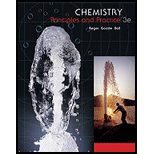
Concept explainers
(a)
Interpretation:
The maximum positive oxidation state of
(a)
Explanation of Solution
The number of electron loosed or gained in the formation if molecule is known as oxidation state or number.
The general electronic configuration of
After removal of 4 electrons it is become,
Not able to remove more electrons from
(b)
Interpretation:
The maximum positive oxidation state of
(b)
Explanation of Solution
The number of electron loosed or gained in the formation if molecule is known as oxidation state or number.
The general electronic configuration of
After removal of 6 electrons it is become,
Not able to remove more electrons from
(c)
Interpretation:
The maximum positive oxidation state of
(c)
Explanation of Solution
The number of electron loosed or gained in the formation if molecule is known as oxidation state or number.
The general electronic configuration of
After removal of 5 electrons it is become,
Not able to remove more electrons from
(d)
Interpretation:
The maximum positive oxidation state of
(d)
Explanation of Solution
The number of electron loosed or gained in the formation if molecule is known as oxidation state or number.
The general electronic configuration of
After removal of 7 electrons it is become,
Not able to remove more electrons from
Want to see more full solutions like this?
Chapter 19 Solutions
Chemistry
- (a) What is the crystal field splitting energy (Δ)?(b) How does it arise for an octahedral field of ligands?(c) How is it different for a tetrahedral field of ligands?arrow_forwardGiving a suitable example for each, explain the following: (i) Crystal field splitting (ii) Linkage isomerism (iii) Ambidentate ligandarrow_forwardDiscuss for reasons which of the following properties the Hexamine Nickel (II) Chloride complex has. Strong field or weak field High spin or low spin Ionic or covalent bondingarrow_forward
 Chemistry: Principles and PracticeChemistryISBN:9780534420123Author:Daniel L. Reger, Scott R. Goode, David W. Ball, Edward MercerPublisher:Cengage Learning
Chemistry: Principles and PracticeChemistryISBN:9780534420123Author:Daniel L. Reger, Scott R. Goode, David W. Ball, Edward MercerPublisher:Cengage Learning Chemistry: Principles and ReactionsChemistryISBN:9781305079373Author:William L. Masterton, Cecile N. HurleyPublisher:Cengage Learning
Chemistry: Principles and ReactionsChemistryISBN:9781305079373Author:William L. Masterton, Cecile N. HurleyPublisher:Cengage Learning Principles of Modern ChemistryChemistryISBN:9781305079113Author:David W. Oxtoby, H. Pat Gillis, Laurie J. ButlerPublisher:Cengage Learning
Principles of Modern ChemistryChemistryISBN:9781305079113Author:David W. Oxtoby, H. Pat Gillis, Laurie J. ButlerPublisher:Cengage Learning General Chemistry - Standalone book (MindTap Cour...ChemistryISBN:9781305580343Author:Steven D. Gammon, Ebbing, Darrell Ebbing, Steven D., Darrell; Gammon, Darrell Ebbing; Steven D. Gammon, Darrell D.; Gammon, Ebbing; Steven D. Gammon; DarrellPublisher:Cengage Learning
General Chemistry - Standalone book (MindTap Cour...ChemistryISBN:9781305580343Author:Steven D. Gammon, Ebbing, Darrell Ebbing, Steven D., Darrell; Gammon, Darrell Ebbing; Steven D. Gammon, Darrell D.; Gammon, Ebbing; Steven D. Gammon; DarrellPublisher:Cengage Learning Chemistry: The Molecular ScienceChemistryISBN:9781285199047Author:John W. Moore, Conrad L. StanitskiPublisher:Cengage Learning
Chemistry: The Molecular ScienceChemistryISBN:9781285199047Author:John W. Moore, Conrad L. StanitskiPublisher:Cengage Learning





